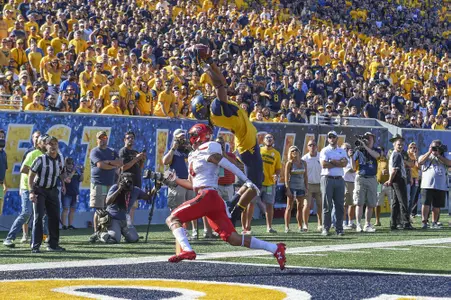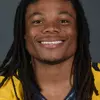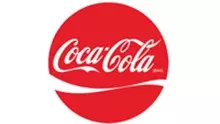
Photo by: All Pro Photography/Dale Sparks
More Than a Passing Fancy
October 15, 2017 01:42 PM | Football
Do you know when you've got a dominant passing game? It's not the touchdowns, the yardage thrown or the high percentage of passes completed, it's what the other team is trying to do to stop you.
And when that includes grabbing, holding, tackling and just about anything else to try and slow you down, that means all else has failed.
Consider what happened to West Virginia's wide receivers during yesterday's 46-35 come-from-behind victory over 24th-ranked Texas Tech.
When the Red Raiders weren't getting to Grier - four times, which is four more times than coach Dana Holgorsen would like - Tech's overmatched DBs were unable to stick with Ka'Raun White, David Sills V, Gary Jennings Jr. and Marcus Simms, choosing instead to grab them and hold on for dear life whenever the football was in the air.
The Red Raider secondary was called for five pass interference penalties, three on one drive alone, and probably could have had more called on them.
For anyone with both eyes open watching last weekend's TCU game, that was also clearly the case. The soon-to-be, top-five Horned Frogs were just as bad as the Red Raiders were in trying to slow down West Virginia's receivers, getting called for four pass interference penalties and one defensive holding call.
Two weeks before that, Kansas was also flagged for a pass interference call which makes 10 PIs against the Mountaineers in their last three games.
That bears repeating: 10 pass interference penalties in the last three games. A team can go a couple of years without drawing that many pass interference calls.
That, to me, is far more impressive than David Sills' NCAA-leading 12 touchdown catches, or Will Grier's 21 touchdown passes, his 65.7 percent completion percentage or his 348.7 yards-per-game average.
There were times yesterday when Grier simply threw the ball up into double- and sometimes triple-coverage knowing his guy had a better chance of coming up with the football than the other three guys around him.
How do you defend that?
Go back to last year's national championship game when Clemson's 6-foot-3-inch, 205-pound Mike Williams made that great leaping catch against Alabama to set up the game-winning touchdown.
Alabama has the best secondary coach on the planet, Nick Saban, and his guys couldn't stop a simple lob pass to a wide receiver who was bigger and more physical than they were.
And that's what West Virginia has right now with its three main receiving weapons - Sills, Jennings and White - three big, physical dudes who can outfight the other guys for the football in the air.
Sometimes the best play is a simple as throwing it up in the air to the biggest guys on the field and watching them come down with it.
"We've got some big, physical receivers," Grier admitted after Saturday's win over Texas Tech. "I trusted (White) to make that play (his game-turning touchdown catch late in the third quarter). There was one he got interfered on and I told him, 'I'm coming back to you.' And I did. I know we have the potential to make those plays."
Which is why Grier put the football yesterday in places where quarterbacks normally don't throw it.
"That's more Will," offensive coordinator Jake Spavital admitted. "We always have that option on every single play, but if he's feeling it and he's got a good sense that Ka'Raun is beating them then I encourage them to keep throwing it in that direction."
"I think we could have had more explosive plays if they didn't interfere," Sills added. "Some of them were like flat-out tackles, basically. Will just gives us shots as receivers and you saw Ka'Raun go up and make a play when he needs to, Gary makes plays, Marcus (Simms) made some great contested catches today so he has a lot of confidence in us."
After last season, West Virginia coach Dana Holgorsen said he wanted bigger, taller, more physical pass catchers with good ball skills.
Now he's got them, including the nation's top touchdown man Sills, recently named to the ESPN mid-season All-America team.
"He thinks he's the baddest dude on the field," Holgorsen said. "His mentality is they can't guard me, they can't cover me."
So, when teams do grab and hold, tackle, push or try and do anything they can to try and knock the receivers out of their rhythm, Grier said it's just a matter of them having to fight through it.
Sometimes flags will be thrown, as was the case yesterday, and sometimes they won't always be thrown as was the case down in Fort Worth a week ago.
"That's something we can't control," Grier said. "If they hold you fight through it and make tough catches and they lived up to that challenge (Saturday). They made a lot of good catches in coverage and we've got to move forward with that.
"They know that they're not going to get every call, they know teams are going to be physical with them and they've got to be physical back and they can't let it affect their game."
Expect even more of this in the coming weeks, beginning next Saturday at Baylor.
Now, about that pass protection …
And when that includes grabbing, holding, tackling and just about anything else to try and slow you down, that means all else has failed.
Consider what happened to West Virginia's wide receivers during yesterday's 46-35 come-from-behind victory over 24th-ranked Texas Tech.
When the Red Raiders weren't getting to Grier - four times, which is four more times than coach Dana Holgorsen would like - Tech's overmatched DBs were unable to stick with Ka'Raun White, David Sills V, Gary Jennings Jr. and Marcus Simms, choosing instead to grab them and hold on for dear life whenever the football was in the air.
The Red Raider secondary was called for five pass interference penalties, three on one drive alone, and probably could have had more called on them.
For anyone with both eyes open watching last weekend's TCU game, that was also clearly the case. The soon-to-be, top-five Horned Frogs were just as bad as the Red Raiders were in trying to slow down West Virginia's receivers, getting called for four pass interference penalties and one defensive holding call.
Two weeks before that, Kansas was also flagged for a pass interference call which makes 10 PIs against the Mountaineers in their last three games.
That bears repeating: 10 pass interference penalties in the last three games. A team can go a couple of years without drawing that many pass interference calls.
That, to me, is far more impressive than David Sills' NCAA-leading 12 touchdown catches, or Will Grier's 21 touchdown passes, his 65.7 percent completion percentage or his 348.7 yards-per-game average.
There were times yesterday when Grier simply threw the ball up into double- and sometimes triple-coverage knowing his guy had a better chance of coming up with the football than the other three guys around him.
How do you defend that?
Go back to last year's national championship game when Clemson's 6-foot-3-inch, 205-pound Mike Williams made that great leaping catch against Alabama to set up the game-winning touchdown.
Alabama has the best secondary coach on the planet, Nick Saban, and his guys couldn't stop a simple lob pass to a wide receiver who was bigger and more physical than they were.
And that's what West Virginia has right now with its three main receiving weapons - Sills, Jennings and White - three big, physical dudes who can outfight the other guys for the football in the air.
Sometimes the best play is a simple as throwing it up in the air to the biggest guys on the field and watching them come down with it.
"We've got some big, physical receivers," Grier admitted after Saturday's win over Texas Tech. "I trusted (White) to make that play (his game-turning touchdown catch late in the third quarter). There was one he got interfered on and I told him, 'I'm coming back to you.' And I did. I know we have the potential to make those plays."
Which is why Grier put the football yesterday in places where quarterbacks normally don't throw it.
"That's more Will," offensive coordinator Jake Spavital admitted. "We always have that option on every single play, but if he's feeling it and he's got a good sense that Ka'Raun is beating them then I encourage them to keep throwing it in that direction."
"I think we could have had more explosive plays if they didn't interfere," Sills added. "Some of them were like flat-out tackles, basically. Will just gives us shots as receivers and you saw Ka'Raun go up and make a play when he needs to, Gary makes plays, Marcus (Simms) made some great contested catches today so he has a lot of confidence in us."
After last season, West Virginia coach Dana Holgorsen said he wanted bigger, taller, more physical pass catchers with good ball skills.
Now he's got them, including the nation's top touchdown man Sills, recently named to the ESPN mid-season All-America team.
"He thinks he's the baddest dude on the field," Holgorsen said. "His mentality is they can't guard me, they can't cover me."
So, when teams do grab and hold, tackle, push or try and do anything they can to try and knock the receivers out of their rhythm, Grier said it's just a matter of them having to fight through it.
Sometimes flags will be thrown, as was the case yesterday, and sometimes they won't always be thrown as was the case down in Fort Worth a week ago.
"That's something we can't control," Grier said. "If they hold you fight through it and make tough catches and they lived up to that challenge (Saturday). They made a lot of good catches in coverage and we've got to move forward with that.
"They know that they're not going to get every call, they know teams are going to be physical with them and they've got to be physical back and they can't let it affect their game."
Expect even more of this in the coming weeks, beginning next Saturday at Baylor.
Now, about that pass protection …
Players Mentioned
Edward Vesterinen | Oct. 28
Tuesday, October 28
Nick Krahe | Oct. 28
Tuesday, October 28
Grayson Barnes | Oct. 28
Tuesday, October 28
Zac Alley | Oct. 28
Tuesday, October 28
















